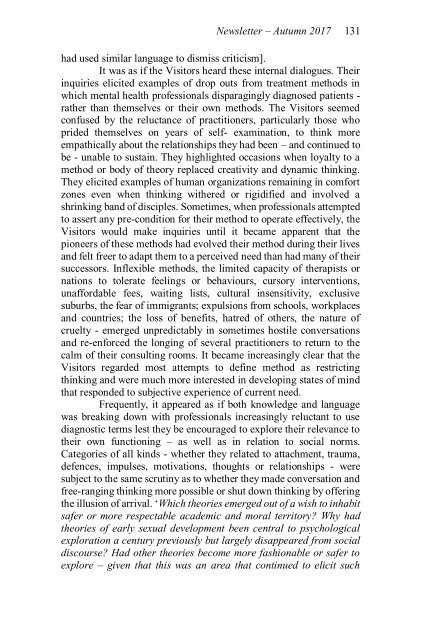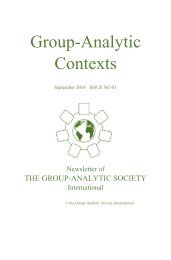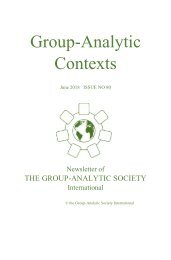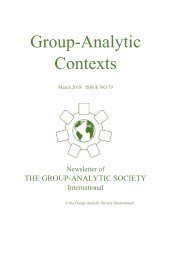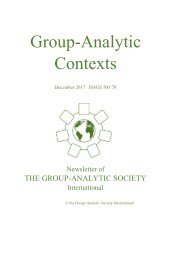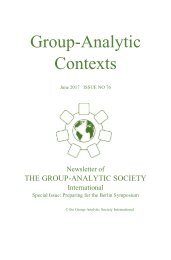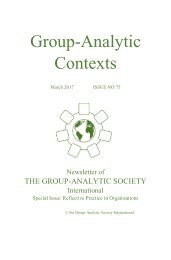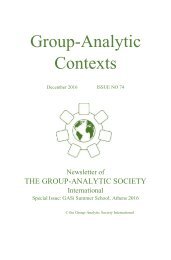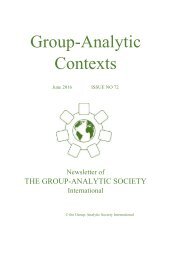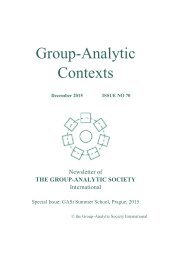Group Analytic Contexts, Issue 77, September 2017
Newsletter of the Group Analytic Society International
Newsletter of the Group Analytic Society International
Create successful ePaper yourself
Turn your PDF publications into a flip-book with our unique Google optimized e-Paper software.
Newsletter – Autumn <strong>2017</strong> 131<br />
had used similar language to dismiss criticism].<br />
It was as if the Visitors heard these internal dialogues. Their<br />
inquiries elicited examples of drop outs from treatment methods in<br />
which mental health professionals disparagingly diagnosed patients -<br />
rather than themselves or their own methods. The Visitors seemed<br />
confused by the reluctance of practitioners, particularly those who<br />
prided themselves on years of self- examination, to think more<br />
empathically about the relationships they had been – and continued to<br />
be - unable to sustain. They highlighted occasions when loyalty to a<br />
method or body of theory replaced creativity and dynamic thinking.<br />
They elicited examples of human organizations remaining in comfort<br />
zones even when thinking withered or rigidified and involved a<br />
shrinking band of disciples. Sometimes, when professionals attempted<br />
to assert any pre-condition for their method to operate effectively, the<br />
Visitors would make inquiries until it became apparent that the<br />
pioneers of these methods had evolved their method during their lives<br />
and felt freer to adapt them to a perceived need than had many of their<br />
successors. Inflexible methods, the limited capacity of therapists or<br />
nations to tolerate feelings or behaviours, cursory interventions,<br />
unaffordable fees, waiting lists, cultural insensitivity, exclusive<br />
suburbs, the fear of immigrants; expulsions from schools, workplaces<br />
and countries; the loss of benefits, hatred of others, the nature of<br />
cruelty - emerged unpredictably in sometimes hostile conversations<br />
and re-enforced the longing of several practitioners to return to the<br />
calm of their consulting rooms. It became increasingly clear that the<br />
Visitors regarded most attempts to define method as restricting<br />
thinking and were much more interested in developing states of mind<br />
that responded to subjective experience of current need.<br />
Frequently, it appeared as if both knowledge and language<br />
was breaking down with professionals increasingly reluctant to use<br />
diagnostic terms lest they be encouraged to explore their relevance to<br />
their own functioning – as well as in relation to social norms.<br />
Categories of all kinds - whether they related to attachment, trauma,<br />
defences, impulses, motivations, thoughts or relationships - were<br />
subject to the same scrutiny as to whether they made conversation and<br />
free-ranging thinking more possible or shut down thinking by offering<br />
the illusion of arrival. ‘Which theories emerged out of a wish to inhabit<br />
safer or more respectable academic and moral territory? Why had<br />
theories of early sexual development been central to psychological<br />
exploration a century previously but largely disappeared from social<br />
discourse? Had other theories become more fashionable or safer to<br />
explore – given that this was an area that continued to elicit such


